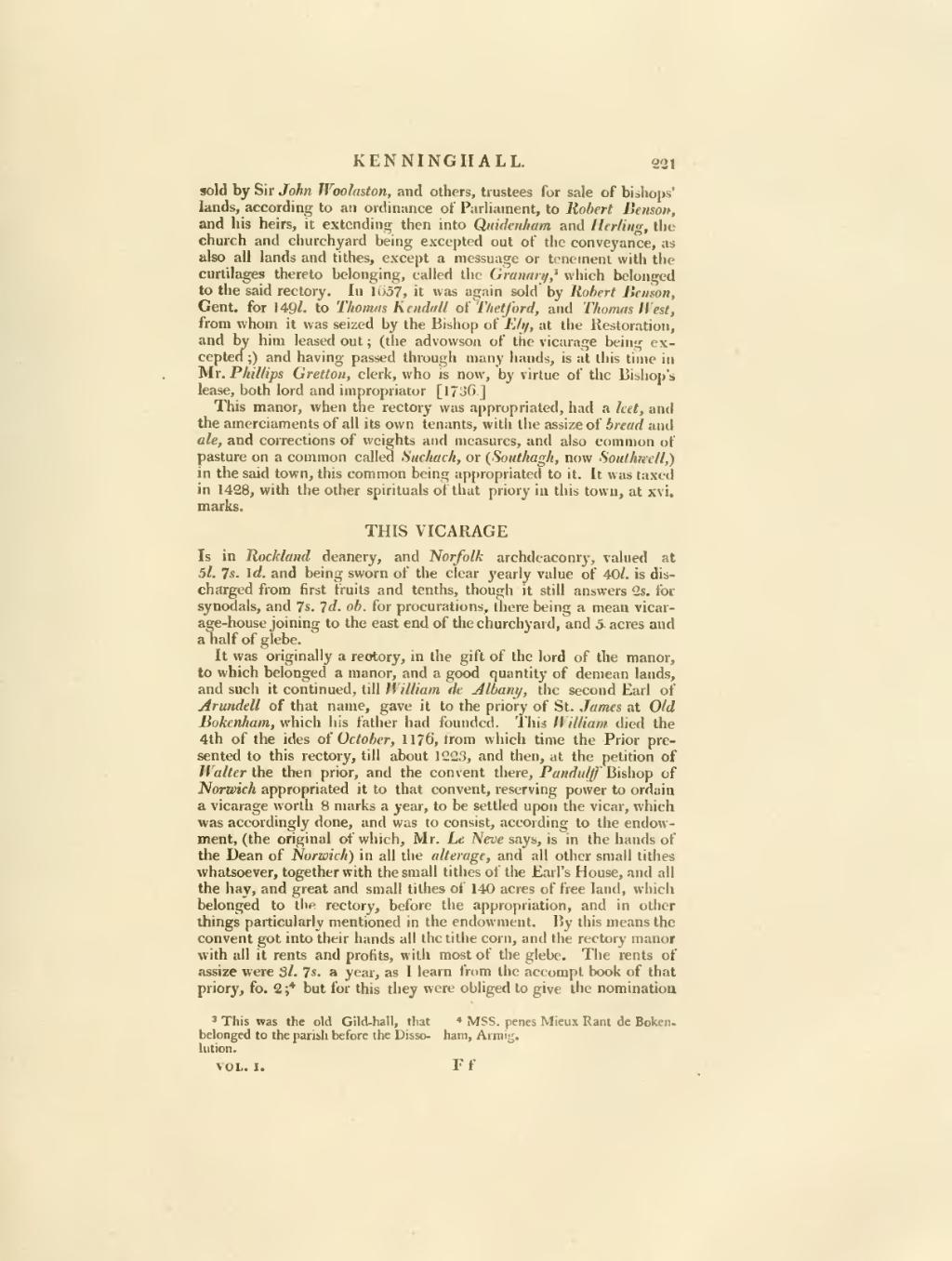sold by Sir John Woolaston, and others, trustees for sale of bishops' lands, according to an ordinance of Parliament, to Robert Benson, and his heirs, it extending then into Quidenham and Herling, the church and churchyard being excepted out of the conveyance, as also all lands and tithes, except a messuage or tenement with the curtilages thereto belonging, called the Granary, which belonged to the said rectory. In 1657, it was again sold by Robert Benson, Gent. for 149l. to Thomas Kendall of Thetford, and Thomas West, from whom it was seized by the Bishop of Ely, at the Restoration, and by him leased out; (the advowson of the vicarage being excepted;) and having passed through many hands, is at this time in Mr. Phillips Gretton, clerk, who is now, by virtue of the Bishop's lease, both lord and impropriator [1736.]
This manor, when the rectory was appropriated, had a leet, and the amerciaments of all its own tenants, with the assize of bread and ale, and corrections of weights and measures, and also common of pasture on a common called Suchach, or (Southagh, now Southwell,) in the said town, this common being appropriated to it. It was taxed in 1428, with the other spirituals of that priory in this town, at xvi. marks.
This Vicarage
Is in Rockland deanery, and Norfolk archdeaconry, valued at 5l. 7s. 1d. and being sworn of the clear yearly value of 40l. is discharged from first fruits and tenths, though it still answers 2s. for synodals, and 7s. 7d. 0b. for procurations, there being a mean vicarage-house joining to the east end of the churchyard, and 5 acres and a half of glebe.
It was originally a rectory, in the gift of the lord of the manor, to which belonged a manor, and a good quantity of demean lands, and such it continued, till William de Albany, the second Earl of Arundell of that name, gave it to the priory of St. James at Old Bokenham, which his father had founded. This William died the 4th of the ides of October, 1176, from which time the Prior presented to this rectory, till about 1223, and then, at the petition of Walter the then prior, and the convent there, Pandulff Bishop of Norwich appropriated it to that convent, reserving power to ordain a vicarage worth 8 marks a year, to be settled upon the vicar, which was accordingly done, and was to consist, according to the endowment, (the original of which, Mr. Le Neve says, is in the hands of the Dean of Norwich) in all the alterage, and all other small tithes whatsoever, together with the small tithes of the Earl's House, and all the hay, and great and small tithes of 140 acres of free land, which belonged to the rectory, before the appropriation, and in other things particularly mentioned in the endowment. By this means the convent got into their hands all the tithe corn, and the rectory manor with all it rents and profits, with most of the glebe. The rents of assize were 3l. 7s. a year, as I learn from the accompt book of that priory, fo. 2; but for this they were obliged to give the nomination of the vicars for ever to the See of Norwich, the Bishops of which ever after nominated to the Prior such persons as they pleased, and if they did not immediately present the person nominated, the Bishop collated him according to the agreement; and least there should be any future claim from the lords of the manor of Kenninghall, to which the advowson formerly belonged, the Prior and Convent got Roger de Montealt, then lord, to confirm to them the advowson, manor, and appropriation. I
